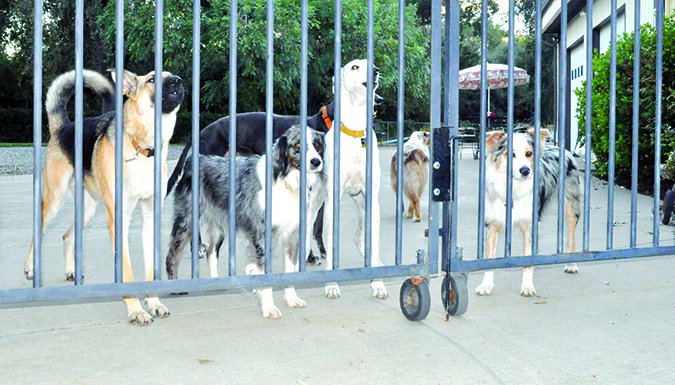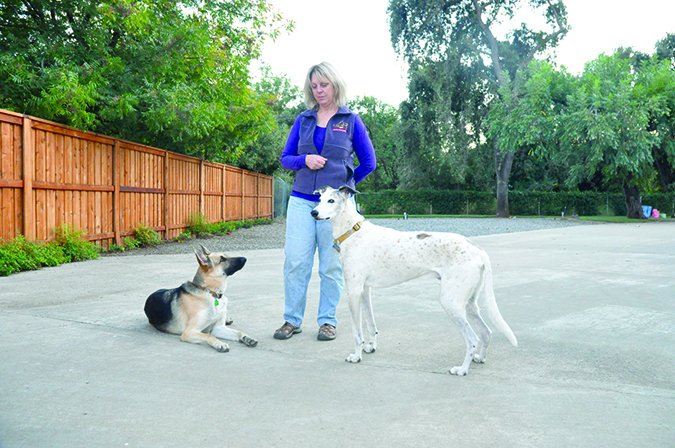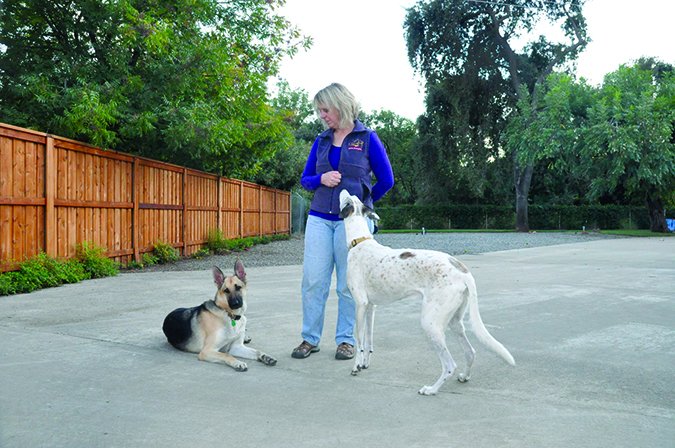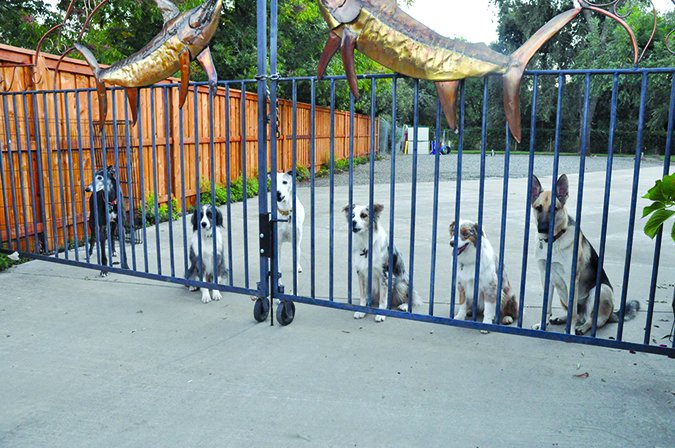[Updated December 14, 2018]
TRAINING MULTIPLE DOGS TO STOP BARKING: OVERVIEW
1. Don’t punish! It may (or may not) suppress barking in the moment, but is unlikely to modify the behavior in the long run. In fact, it may actually make the barking worse or cause new behavior problems.
2. Teach your vocal dogs a positive interrupt so you can minimize their barking behavior.
3. Learn how to apply operant and counter-conditioning protocols to modify your dogs’ barking when you can’t or don’t wish to manage the behavior.
4. Have reasonable expectations: accept barking is normal and appropriate for dogs. Identify times when you can allow your dogs to vocalize.
It’s feeding time at the Miller household. All is calm until I pick up Scooter’s bowl to carry it to the laundry room where the little Pomeranian can eat without harassment from the larger dogs. As I lift the bowl from the counter, Scooter erupts with high-pitched barking and spinning, and Lucy the Corgi joins in with her deeper-but-still-sufficiently irritating vocals. It’s more of an annoying bit of ritual than a dangerous or disturbing one, but it’s annoying just the same, and one that would be nice to extinguish.

But how does one modify behavior if the protocol requires the offering and removal of reinforcement based on the subject’s behavior, when there are two subjects, and reinforcement for one automatically reinforces the other? Stated in plain English, how do I get two (or more) dogs to stop barking when rewarding the quiet one also rewards the barking one?
When One Dog Starts Barking, the Rest Follow
If I set the bowl back down on the counter when both dogs bark, I’m using negative punishment; the dogs’ behavior of barking makes the good thing – delivery of their meal – go away. When the dogs stop barking I use positive reinforcement; the dog’s quiet behavior results in a good thing: I pick up the bowl and proceed with delivery of dinner.
Now, here’s the dilemma: When I pick up the bowl, Lucy stays quiet, so I should positively reinforce that by continuing with dinner delivery. But Scooter starts barking again; I need to abort delivery so I’m not reinforcing Scooter’s barking. But if I set the bowl back down, I’m punishing Lucy for being quiet. Get it?
The answer to the dilemma is this: I can modify the behavior of only one dog at a time. I need to select which dog I want to work with first, and figure out how to manage the other dog’s behavior until I’m ready to work with her. In this scenario, I might change my dog-feeding routine by putting Lucy in my office before I begin food preparation so I can work with Scooter’s barking behavior. After he gets his dinner, I can let Lucy out to join the rest of the group, and feed all of them.
When Scooter no longer barks at food delivery time, I can try reintroducing Lucy to the mix. If her barking re-triggers Scooter’s barking, then I might need to put Scooter away while I work on modifying Lucy’s barking. When each can handle dinner delivery without barking, then I can try them together.
Counter-Conditioning Multiple Dogs at Once
Many multi-dog training programs break down because owners, understandably, aren’t always willing to work with the dogs separately. The prospect of implementing multiple behavior modification programs for multiple dogs can be quite daunting. We’re lucky only two of our five dogs bark at dinnertime. If all five joined in, the cacophony of barking would be overwhelming, not to mention the prospect of working with each of five dogs to modify barking behavior. They might never get fed!

Yet, individual modification work is almost always necessary for success with behaviors that involve multiple dogs. One dog’s barking just sets the other(s) off if the other’s barking hasn’t been solidly modified. Perhaps the two most common examples of multi-dog barking are when an owner walks two or more dogs on leash at one time, or when multiple dogs in a home (or in the yard) are aroused by some stimulus, such as someone at the door, someone walking past on the sidewalk, a squirrel or cat running across the yard or up a tree, a car going by . . .
I see the pained expression on my clients’ faces when I suggest to them that they need to walk their dogs individually, or at least with separate handlers. In many households, one person is in the habit of taking both (or all) dogs for a walk at the same time. I can see them doing the math in their heads; a 30-minute walk per day with three dogs has suddenly compounded into three 30-minute walks, or 90 minutes per day. That equals 10.5 hours per week instead of 3.5 hours. Wow. Who has that much extra time to devote to dog walking?
Still, it’s important. When dogs-on-leash are barking at an outside stimulus, such as another dog or a passing car, my favorite approach to modification is counter-conditioning. The instant your dog sees another dog (or the approaching vehicle), feed bits of chicken (or other very high-value treat), preferably before your dog begins barking. Pause, let him look at the approaching dog (car), and quickly feed more chicken, again before he barks. Continue with your pause/look/treat procedure until the dog (or car) has passed. Then resume your walk until the next dog (car) comes along.

Over time, your dog will learn that the appearance of another dog/car makes you feed him chicken, and instead of barking, he’ll look to you for chicken. This works whether the stimulus causing him to bark is a dog, a car, a kid on a bicycle, or anything else. In time, as his “stimulus/chicken” association becomes very strong, you’ll be able to gradually – and significantly – reduce the amount of chicken you have to feed. In time, you’ll be able to leave the chicken home and just use his regular everyday treats to reinforce his looks at you when a target passes.
As simple as this process is, it’s virtually impossible to do it with two dogs at the same time. The timing of your treat delivery is critical; it must happen the instant after your dog sees the stimulus but before your dog starts to bark. You simply can’t manage two potential barkers and get the timing right for both. Hence the mandate to walk one dog at a time – or at least one dog per handler – if you’re serious about getting the barking under control. When you have solidly established the conditioned emotional response (CER) – the “where’s my chicken look” – for each dog separately, you can begin to walk them together.
Multi-Dog Training: Positive Interrupt
You can modify multi-dog “someone’s at the door” barking in a similar fashion – but it’s harder because all the dogs are usually in the home. You could do a lot of one-at-a-time set-ups with the other dogs out of earshot. (See “Knock, Knock,” WDJ February 2010). Still, chances are when someone comes a-knockin’, at least one of your multiple dogs may bark, which just might set everyone off. The same is true with outside/backyard stimuli. Despite your best efforts to counter-condition, the arousal behavior of multiple dogs is likely to cause mutual escalation or arousal, and barking will happen.
For those times, a positive interrupt is a powerful tool. I use a voice cue (“Over here!”) as a positive interrupt for an individual dog, but in the chaos of multi-dog barking, a louder signal is called for. If you are blessed, as I am, with the ability to give a shrill mouth-whistle, that can work. If not, there are wonderful whistles for sale that are so loud you’ll need to cover your ears when you blow them, or risk damage to your hearing. My favorite is the Storm Whistle. You might want to buy several, so you can stash them in strategic locations around your house and yard.

You’ll want to “charge” your whistle in the same way you charge a clicker, to give your dog a very positive association between the sound of the whistle and something wonderful. I tend to fall back on chicken as my favorite “something wonderful” – dogs usually love it, and it’s relatively low-fat, low-calorie, so you can use it generously without adding too many pounds to your dog, and with a low risk of tummy upsets.
Charge the whistle one dog at a time. With one dog close to you and the others put away out of earshot, blow the whistle (not too loudly) and feed a treat. Blow the whistle, feed a treat. Repeat many times. When your dog makes the connection between whistle and chicken, you’ll see his eyes light up at the sound, and he’ll be looking for the treat. Next, go out in the yard where he can be farther away from you, and repeat your whistle/treat routine, until the sound of the whistle brings him running for a treat even when he’s some distance away, sniffing the ground. Now put him away and try it with the next dog. When all dogs are “charged,” try it with two dogs at a time, gradually adding dogs to the group until your entire pack will interrupt what they’re doing and come running to you at the sound of the whistle. (By the way, this doubles as a great recall tool as well!)
Now you’re ready to try it for real. If you’re confident your dogs will respond, give it a try with the whole pack. If you think that’s too much for your canine pals, start your real life trials one, or maybe two dogs at a time, just like you did with charging the whistle. Arrange a set-up that you know will trigger your dog(s) to bark. Have your whistle handy. When the barking starts, blow the whistle, and reward your dogs generously when they stop barking and come running to you. Then pat yourself on the back.
Continue practicing with set-ups for as many different stimuli as you can think of. The more you practice, the better your dogs will respond when real-life stimuli trigger a bout of barking. If you’re really good, your dogs may start running to you in anticipation of the whistle/treat game when they see or hear stimuli that used to cause barking. When that happens, you deserve to reinforce yourself with dinner and a movie.
Pat Miller, CBCC-KA, CPDT-KA, CDBC, is WDJ’s Training Editor. Author of numerous books on positive dog training, she lives in Fairplay, Maryland, site of her Peaceable Paws training center, where she offers dog training classes and courses for trainers.
Thanks to Sarah Richardson, CPDT-KA, CDBC, Chico, California, for modeling for this article.





